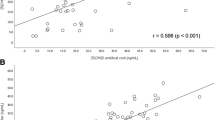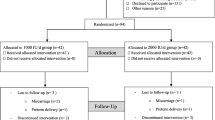Abstract
The vitamin E status of AGA preterm infants (birth weights≦1500 g) was studied during the first 10 weeks of life. The total polyunsaturated fatty acid content of the diet was 12%, and medicinal iron was given from 4 weeks of age. Plasma vitamin E concentrations correlated significantly with β-lipoprotein levels in the infants not supplemented with tocopherol. The low plasma vitamin E levels observed in these infants thus reflect the low transport capacity of the plasma, and do not necessarily signify vitamin E deficiency. Erythrocytes from the preterm infants showed increased hemolysis in the hydrogen peroxide hemolysis test, also when the plasma tocopherol levels were above 11.6 μmol/l; and for the same level of tocopherol, the degree of hemolysis varied considerably. This indicates that factors other than the tocopherol concentrations influence this test. When glucose was added to the cells during the test the hemolysis decreased. A group of infants supplemented with 7.5 IU water-soluble tocopherol/day showed satisfactory median levels of the vitamin, both when assessed as plasma vitamin E concentrations and as vitamin E/β-lipoprotein ratios. However, some infants had low plasma concentrations and ratios, particularly at 4 weeks of age. This indicates that this supplementary dose is insufficient when a water-soluble preparation is used. A very wide range of plasma vitamin E concentrations was observed in the supplemented infants. A word of caution against too vigorous supplementation in small preterm infants is therefore warranted.
Similar content being viewed by others
References
Bieri JG (1975) Vitamin E. Nutr Rev 33:161–167
Dallmann PR (1974) Iron, vitamin E, and folate in the preterm infant. J Pediatr 85:742–752
Ehrenkranz RA, Bonta BW, Ablow RC, Warshaw JB (1978) Amelioration of bronchopulmonary dysplasia after vitamin E administration. N Engl J Med 299:564–569
Farrell PM, Bieri JG (1975) Megavitamin E supplementation in man. Am J Clin Nutr 28:1381–1386
Farrell PM, Bieri JG, Fratantoni JF, Wood RE, di Sant'Agnese PA (1977) The occurence and effects of human vitamin E deficiency. J Clin Invest 60:233–241
Farrell PM, Levine SL, Murphy D, Adams AJ (1978) Plasma tocopherol levels and tocopherol-lipid relationships in a normal population of children as compared to healthy adults. Am J Clin Nutr 31:1720–1726
Gairdner D, Marks J, Roscoe JD (1955) Blood formation in infancy. Part IV. The early anaemia of prematurity. Arch Dis Child 30:203–211
Gairdner D, Pearson J (1971) A growth chart for premature and other infants. Arch Dis Child 46:783–787
Gordon HH, Nitowski HM, Cornblath M (1955) Studies of tocopherol deficiency in infants and children. I. Hemolysis of erythrocytes in hydrogen peroxide. Am J Dis Child 90:669–681
Gross S, Melhorn DK (1974) Vitamin E-dependent anemia in the premature infants. III. Comparative hemoglobin, vitamin E, and erythrocyte phospholipid responses following absorption of either water-soluble or fat-soluble d-alpha tocopheryl. J Pediatr 85:753–759
Hågå P, Lunde G (1978) Selenium and vitamin E in cord blood from preterm and fullterm infants. Acta Paediatr Scand 67:735–739
Johnson L, Schaffer D, Boggs TR Jr (1974) The premature infant, vitamin E deficiency and retrolental fibroplasia. Am J Clin Nutr 27:1158–1173
Melhorn DK, Gross S (1971) Vitamin E-dependent anemia in the premature infant. I. Effects of large doses of medicinal iron. J Pediatr 79:569–580
Oski FA (1980), Vitamin E—a radical defense. N Engl J Med 303:454–455
Oski FA, Barness LA (1967) Vitamin E deficiency: A previously unrecognized cause of hemolytic anemia in the premature infant. J Pediatr 70:211–220
Phelps DL (1979) Vitamin E: Where do we stand? Pediatrics 63:933–935
Ritchie JH, Fish MB, McMasters V, Grossman M (1968) Edema and hemolytic anemia in premature infants. A vitamin E deficiency syndrome. N Engl J Med 279:1185–1190
Williams ML, Shott RJ, O'Neal PL, Oski FA (1975) Role of dietary iron and fat on vitamin E deficiency anemia of infancy. N Engl J Med 292:887–890
Author information
Authors and Affiliations
Additional information
with the technical assistance of Sissel Kran
Rights and permissions
About this article
Cite this article
Hågå, P. Plasma vitamin E levels and vitamin E/β-lipoprotein relationships in small preterm infants during the early anemia of prematurity. Eur J Pediatr 136, 143–147 (1981). https://doi.org/10.1007/BF00441916
Received:
Issue Date:
DOI: https://doi.org/10.1007/BF00441916




